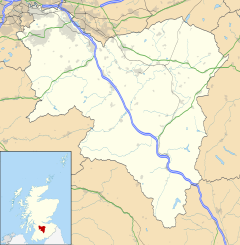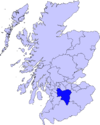Carnwath
Carnwath
| |
|---|---|
 The Carstairs meanders near Carnwath | |
 Carnwath Location within South Lanarkshire | |
| Population | 1,447 |
| OS grid reference | NS979464 |
| Council area | |
| Lieutenancy area | |
| Country | Scotland |
| Sovereign state | United Kingdom |
| Post town | LANARK |
| Postcode district | ML11 |
| Dialling code | 01555 |
| Police | Scotland |
| Fire | Scottish |
| Ambulance | Scottish |
| UK Parliament | |
| Scottish Parliament | |
| Website | https://www.visitlanarkshire.com/explore/carnwath/ |
Carnwath (Gaelic: A' Chathair Nuadh; English: "New Fort") is a moorland village on the southern edge of the Pentland Hills of South Lanarkshire, Scotland. The village lies about 30 mi (50 km) south of both Edinburgh and Glasgow. It is bounded by the North Medwyn and South Medwyn watercourses.
Carnwath is a farming town set in rolling countryside, on the edge of open moorland and with views to the Pentland Hills. Its proximity to the A70 makes it popular with commuters to Edinburgh.
Carnwath is at the heart of Scotland's central belt and has been reputed to be the town furthest away from the sea anywhere in Scotland, though only being 26 miles (42 km) from the coastal resort of Portobello, it falls well short of the distance from the sea of towns such as Kingussie and Pitlochry.
Little remains of the original castle, but the motte on which it was built can still be seen at the Carnwath Golf Club (founded 1907), at the west end of the village.
Carnwath also hosts the oldest foot race in Scotland, possibly Europe, the Red Hose Race, dating back to 13 March 1508. It has seen many changes over almost 500 years, but the running of The Red Hose is still a strong tradition in Carnwath. Hose being the Scots word for stockings or long socks. Each year a foot race is run at Carnwath and the local Laird must provide a pair of red stockings as the prize.
The Wee Bush Inn, until a fire, was the last pub in Scotland to have a thatched roof. For insurance purposes it has had to be replaced with a slate roof. The Inn's other claim to fame is that actor Oliver Reed was a regular customer.[1]
History[]
At the centre of Carnwath is Carnwath Cross, the mercat cross, set back a little where the Main Street widens to form the Market Square. This was erected by the 5th Lord Somerville in 1516 to celebrate the granting of burgh status to the village in 1514.
On the opposite side of the main road from the golf club and motte is Carnwath Parish Church. Initially the architectural style appears to be a standard 19th century church with spire, but the west side reveals an almost separate tiny chapel, St Mary's Aisle, a surviving part of the collegiate church founded here in 1425 by Thomas, First Lord Somerville and incorporating an earlier church established in 1386.
St Mary's Aisle is the only remaining part of the Collegiate Church built in Carnwath in 1386. It stands at the west entrance to Carnwath alongside the parish church and is recognised as a Category A listed building. St Mary's Aisle is the mausoleum of the Lockhart family and previously of the Earls of Carnwath and the Lords Somerville.
In 1630, the Carnwath estate, then owned by the Earl of Mar was purchased by Sir Robert Dalzell, later to become Lord Dalzell. In 1639, his son, Robert the 2nd Lord Dalzell, was further elevated to become the Earl of Carnwath. The title was forfeit in 1716 when the 5th Earl of Carnwath, Robert Dalzell was attainted due to his support of the Jacobite cause during the Fifteen, however the titles were restored to the family in 1826.[2][3][4]
Writer, spy and politician, George Lockhart, inherited the Carnwath estates from his father, Sir George Lockhart, of the Lockharts of Lee, who had purchased them in 1681 from the Earls of Carnwath.
The Ordnance Gazetteer of Scotland (1882–1885) said the village was: "Long a dingy and disagreeable place, it has been greatly improved".[2]
There is a Gothic church that dates from 1798, directly abutting the former tiny church of 1424.
Other buildings of note in the village include the old primary school on Main Street, dated 1876 and abandoned since 2006. Additionally, within King George's Park sits a 1935 sports pavilion, formerly used by Carnwath Bowls Club.
In 1845 the area became a civil parish.
Carnwath railway station, originally part of the Caledonian Railway, later the London, Midland and Scottish Railway and finally the Scottish Region of British Railways, was closed in the Beeching Axe in the 1960s.
Famous people from Carnwath include the first woman provost of Kirkintilloch, Jenny Coutts, author and critic, Robert Anderson, footballer, Tom Brownlee and the Ordnance Gazetteer remarks that: "the minor poet, James Graeme (1749-72)" was a resident of the locality.[2]
Education[]
There is a nursery school in the village which is part of the Biggar Learning Community, that includes the Biggar High School A new school was built and opened in 2015.[5]
A notable spell of cold weather[]
In January 1979 the temperature in Carnwath sank to −24.6 °C (−12.3 °F), which was the lowest temperature recorded anywhere in the British Isles in the 1970s.[6]
In popular culture[]
Carnwath is mentioned twice in the traditional song We're No' Awa' Tae Bide Awa', also known as Carnwath Mill.[7]
So we had a hauf an' anither hauf,
And then we had anither,
When he got fou' he shouted
"Hoo!
It's Carnwath Mill for ever."
For we're no' awa' tae bide awa' , etc.
And:-
So whenever friendly friens may meet,
Wherever Scots foregather,
We'll raise our gless, we'll shout
Hurroo,
It's Carnwath Mill for ever.
The allusion is obscure. Carnwath Mill is a farm (and formerly, a mill) about 1 mile (1.5 kilometres) from Carnwath; alternatively, there was a lint mill at Carnwath erected in 1762;[8] the former survives as a house and holiday let and The Lint Mill hosts a B&B and is an organic smallholding. The song also alludes to Wilsontown, which was about 6 miles (10 kilometres) away.
See also[]
- Caledonian Amateur Football League, Balmore who form part of the league play at Carnwath Village Park
- Lanark Blue, a locally made sheep's milk cheese
- Cobbinshaw Reservoir, a Site of Special Scientific Interest (SSSI)
References[]
- ^ Visit Lanarkshire
- ^ Jump up to: a b c The Ordnance Gazetteer of Scotland
- ^ The Peerage
- ^ Dalzell
- ^ Carnwath Primary School[permanent dead link]
- ^ "trevorharley.com". Archived from the original on 14 December 2015. Retrieved 12 December 2016.
- ^ "We're No' Awa' Tae Bide Awa' ". Traditional Scottish Songs. Retrieved 7 July 2020.
- ^ McClain, N.E. (1970). "Scottish Lintmills, 1729–70". Textile History. 1 (3): 293–308. doi:10.1179/004049670793692545.
External links[]
| Wikimedia Commons has media related to Carnwath. |
- A local man's page of maps and photos
- Dunsyre.com and Dunsyre.net Information about Dunsyre and links to local pages.
- Dunysre Holiday Camp
- Carnwath Primary School
- Villages in South Lanarkshire

